Ankle Foot Exerciser
Introduction
Thanks for Your Purchase
We are very glad having you as customer, enjoy exercising and let us know how fast you are progressing! You made the right choice, Ankle Foot Exerciser has been designed to help everybody having stronger ankles and feet, procuring better posture, less injuries... no required skills, no equipment, anywhere, even in the water to have smoother sensations, before running to have a more responsive foot and a more efficient stride, after a long trek to release ankle's tension. Just 3 minutes to complete an exercise (when brushing your teeth!), no extra space required.
Unique design Ankle Foot Exerciser
Ankle Foot Exercise is a modular kit of 4 blocs. The device is so simple to use that it is now integrated into the ankle rehabilitation process by high-level athletes.
Packaged in a set of four colored squares, each plate is 4 inches long with a distinctive base to vary the type and level of exercise performed.
Black: Full stability: 2 full cylinders placed at the sides of the square.
Red and Blue: Medium instability: 2 half cylinders placed in the center of the square.
White: Full instability: a half ball shape placed in the center of the square.
Ankle Foot Exerciser is Life changing!
When it comes to precision therapeutic ankle and foot exercises, the ability to bias the weakest link and train specifically, this is what matters. When working out on the Ankle Foot Exerciser, results are exclusively targeted on ANKLE and FOOT.
- Security: low amplitude prevent any risk of accident (ligaments cannot be damaged), the square touches the ground at the slightest imbalance
- Low angular clearance allows to target specifically ankle and foot. This is such a difference with other devices with offer a big angular clearance that knee and hip have a predominant role in the attempt of stabilization
- Angular ankle and foot displacement will limit the action of the sensory neurons located in the inner ear which are in control of the body balance, and the cerebellar system, which regulate coordination
- Placed on 2 instable squares, it allows for each exercise, to dissociate the front foot from the back foot. This is the only way to target specific muscles of the ankle and the foot individually.
FOR STABILIZED ANKLES

The ankle, or the talocrural region, is the region where the foot and the leg meet. In motion, the foot orients obliquely from top to bottom, from inside to outside and from front to back around the transverse axis of the talocrural joint. It is not a pure movement at the level of the hindfoot, but rather a combination of two complex movements that cross the three anatomical planes of the body:
| Eversion | Inversion |
|---|---|
| Combination of dorsal flexion, pronation and abduction | Combination of plantar flexion, supination and adduction |
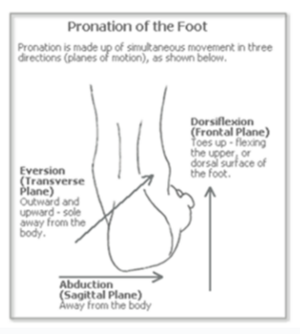 |
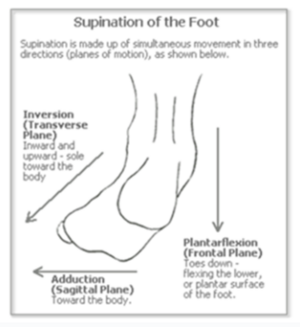 |
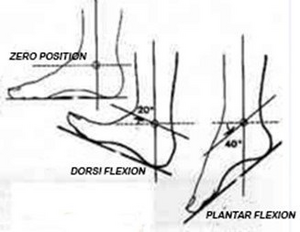
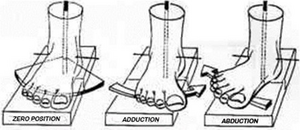
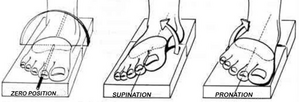
When working out on the Ankle Foot Exerciser, people report it is more difficult to find balance than on any balance board. Why? Because muscle soreness occurs specifically on the ankle's muscles. On other devices, muscular reaction is not the same, muscle soreness occurs on the whole low part of the body.
Targeting specifically on the ankle's muslces:
- Increase lateral (adduction and abduction) range of motion
- Improve the ankle's ability for pronation or supination by training specifically rotation muscles depending on whether you are pronator or supinator
- Enhance a better dorsiflexion (dorsal flexion): ankle dorsiflexion restrictions can hinder performance and lead to dysfunctional movement patterns. Specific exercises based on back foot segments with the white square (half ball shape) will improve ankle dorsiflexion range of motion.
FOR STABILIZED FEET
Man owes a lot to the foot. This organ has no less than 26 bones, 16 joints, 107 ligaments and 20 intrinsic muscles that allowed him to acquire standing, which reoriented its skull, eyes and mouth. The maintenance of standing could not have been done without this slow adaptation. If the foot had not evolved to the appearance, it has today, we would still live in trees or caves.
It is estimated that 70 kilograms per square centimeter is the pressure exerted on the sole of the foot. When working out on the Ankle Foot Exerciser, dissociated training allows to muscle the back foot and soliciting at the same time the front foot moderately and vice versa.
Targeting specifically on front foot and back foot:
- Reinforce foot muscular tonicity, hence dynamize the foot motion fluidity (on walking on running), and avoid all loss of energy
- Reduce foot pain from plantar fasciitis, Achilles' tendonitis, heel, arch pain. Effective stretching increase range of motion and flexibility which relieve the muscular and articular pains
- Allow to cushion in a better way the transmission of the top-down and bottom-up forces
- Improve both elasticity on reception and rigidity on propulsion
- Give a better balance to the whole body
FOR RECOVERING FROM INJURY
Sprain of the external lateral ligament of the ankle is, without a doubt, the most common traumatic pathology. The sprain (infringement) of ankle, it is more than 24,000 cases per day in U.S.A.
During improper support, the stabilizing muscles of the ankle and foot are not strong enough to prevent excessive twisting of the ankle.
On a movement of plantar flexion, adduction, supination, stretching very strongly, the foot rocks inside, thus causing a tearing of the external lateral ligament. The foot goes into inversion, the spillers are stretched and do not contract fast enough to counter the lesion movement. The foot loses its ability to react. It therefore needs to:
- Rest, ice, ankle elevation
- Gently mobilize the joint (lymphatic drainage) to evacuate swelling, blood effusion
- Re-education to return to a normal range of motion despite the hours spent in the splint.
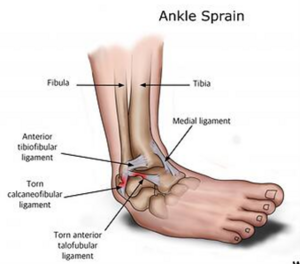
Ankle Foot Exercising leads to rapid recovery, the downtime after a sprain is greatly decreased.
- Constitution of a solid scar thanks to the orientation of the fibers in the axis of the constraints, we speak of mechanization
- Greater stimulation of the fibers (both nits and rapids) of spillers and inverters
- Improvement of muscle typology with the development of fast fibers of type II
- Improvement of reflex loops and thus allow a rapid and effective contraction
- Optimum reinforcement of inverters that must be stronger than spillers to avoid sprained ankle
FOR PREVENTING RECURRENCE
There are different degrees of sprain, sometimes we twist our foot without realizing it, which creates micro damage to the ligament. These mini sprains, not being treated, give risks of recurrence. Chronic instability with episodes of repeated sprains and whose triggering factors are less and less frank, threatens anyone who has already had a serious ligament tear. The recurrence rate is 80%!
A torn ligament regains its continuity after 6 weeks... but it is only solid after 6 months! Throughout this period, recidivism threatens! During this period, the ankle is not at 100% of these abilities, it is vulnerable.
Continuous self-rehabilitation with Ankle Foot Exerciser is the essential weapon to fight against chronic ankle instability and thus minimize the risk of relapse! No excuses: when you're on the go, the 4 squares are so small that they fit in any (sport) bag!
FOR IMPROVING PROPRIOCEPTION
Proprioception, also called neuromuscular reprogramming, refers to all the receptors, pathways and nerve centers involved in the perception, conscious or not, of the relative position of parts of the body in relation to one another.
Having already suffered an injury on foot or ankle can affect somatosensory system and decrease balance. Following an injury, it is therefore important to regain proprioception as quickly as possible, to makeit possible to rehabilitate a stable ankle or foot.
The ligament not only has a mechanical role to limit abnormal joint movements, but it also has a position information mission. Nerve sensors of tension are found in the ligaments, in the case of a sprain, these are damaged.
Neuromuscular reprogramming on Ankle Foot Exercisers promotes:
- A gradual relearning of perceptions from our own body by acting on the muscle-tendon complex and the motor plate-neuron junction
- The regeneration of new fibers inside the ligament that have been injured during a sprain.
- Muscle balance and joint safety, thanks to the succession of AGONIST and ANTAGONISTS exercises.
FOR A GOOD POSTURE
Take a moment (right now) to check your posture. Are you slouching? Are you leaning to the side? Is your head jutting forward? Small details like these make long term differences in life. Take care of yourself, each and every day.
Strong feet supporting stabilized ankles are the foundation tip-top shape!
As we progress in life, we start sitting more and walking less (man since his creation has always walked, our grandparents without car walked 3 times more), eventually losing motion and strength. The foot is our base of support and distribute upward and downward force through our body. If the foot or ankle is weak, stuck or out of alignment, it leads to an uneven distribution causing back pain, bulged discs, sciatica, hip pain, and knee pain. If we strengthen, realign, and stabilize our ankles and feet, we can change everything.
Simple, fast and effective, the Ankle Foot Exerciser will get you back into the game of life.
With regular use, we can keep our whole body in good posture, and pain free to live to the fullest.
FOR REALIZING YOUR DREAMS
May it be:
- For curative actions on treatments linked to foot and heel pains, plantar fasciitis, Achilles' tendonitis.
- To re-educate faster after ankle sprain and hence reducing downtime.
- For youngest exercising in a fun way, to adopt a good posture from early childhood
- For adults to realign spine from the bottom, reduce knee, back pains,
- For elderly people to tackle ankle instability,
- To move faster running, swimming, boxing, ...
- for baskets, tennis, soccer, ... players to strengthen feet and ankles,
- For gymnasts, yoga, Pilate practitioners to have a better range of motion,
- For adventurers, challengers, when having a good balance is a must to go beyond limits.
Ankle Foot Exerciser is your SKYROCKET to reach your up to the moon GOALS, whatever your age, physical condition!
NOW LET'S START!
DISCLAIMER:
- Use the Ankle Foot Exerciser on a hard and non-slippery ground. Arrange your space in such a way as to avoid any possible injury. Whatever your level of balance, always remember to have a point of support (chair, table, wall...) to catch up in case of a fall.
- Consult your physiotherapist or doctor for personal advice.
- Test your balance: you must be able to stay balanced on one foot at least 30 seconds before training on the Ankle Foot Exerciser.
- If pain occurs, stop yourself! No pain should be allowed. You may not have warmed up your foot or ankle enough, or you may be going too fast, or too hard in intensity.
- If you have had a sprained ankle with bone tear, the healing of the ligaments takes at least 6 to 8 weeks. It is advisable to keep the body active by working on sheathing, bodybuilding. At the end of the 8th week, start he reeducation working on on the Ankle Foot Exerciser to promote the constitution of a solid scar thanks to the orientation of the fibers in the axis of the constraints, enhancing an efficient recovery and preventing recurrence. If you have had a sprained ankle without ultrasound markers showing ligament tear, in this case this is not a sprain but just an instability, then it is advisable to strengthen the ankle as soon as possible, working out on the Ankle Foot Exerciser.